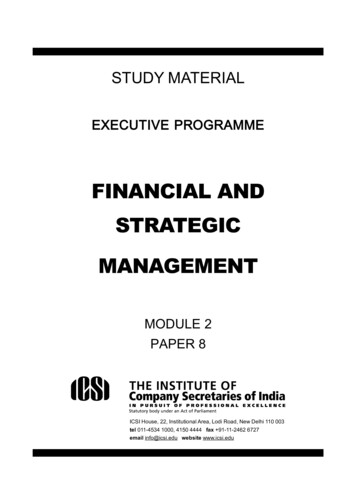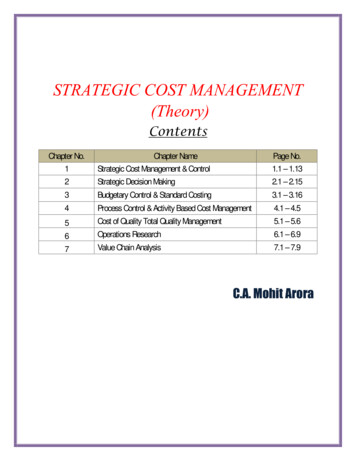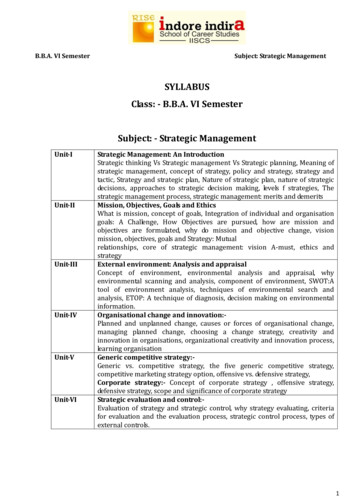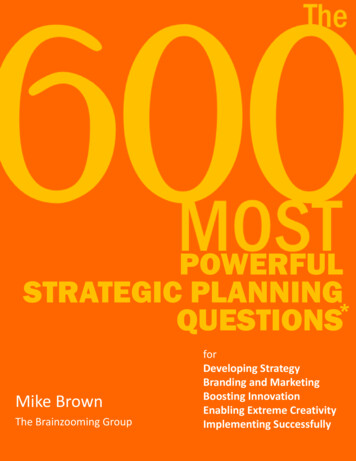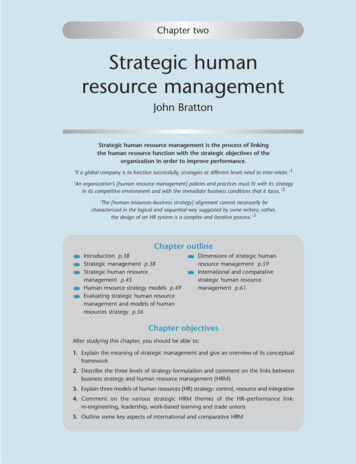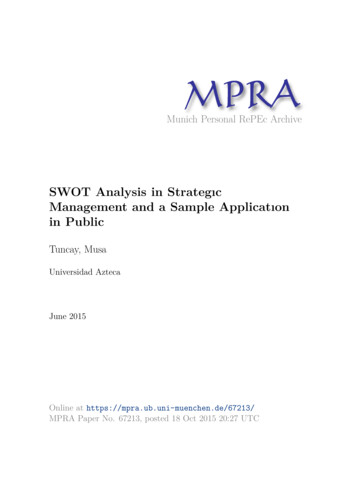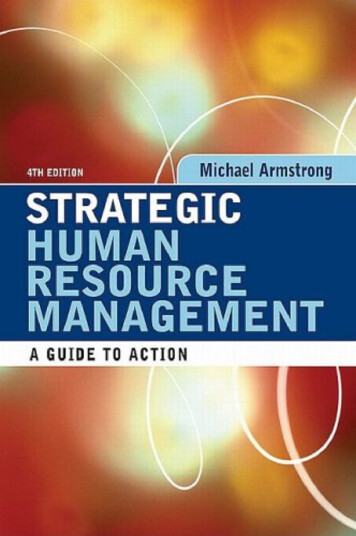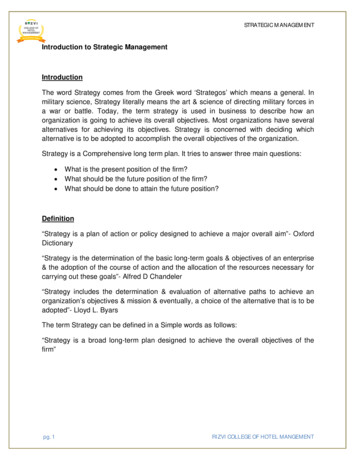
Transcription
STRATEGIC MANAGEMENTIntroduction to Strategic ManagementIntroductionThe word Strategy comes from the Greek word ‘Strategos’ which means a general. Inmilitary science, Strategy literally means the art & science of directing military forces ina war or battle. Today, the term strategy is used in business to describe how anorganization is going to achieve its overall objectives. Most organizations have severalalternatives for achieving its objectives. Strategy is concerned with deciding whichalternative is to be adopted to accomplish the overall objectives of the organization.Strategy is a Comprehensive long term plan. It tries to answer three main questions: What is the present position of the firm?What should be the future position of the firm?What should be done to attain the future position?Definition“Strategy is a plan of action or policy designed to achieve a major overall aim”- OxfordDictionary“Strategy is the determination of the basic long-term goals & objectives of an enterprise& the adoption of the course of action and the allocation of the resources necessary forcarrying out these goals”- Alfred D Chandeler“Strategy includes the determination & evaluation of alternative paths to achieve anorganization’s objectives & mission & eventually, a choice of the alternative that is to beadopted”- Lloyd L. ByarsThe term Strategy can be defined in a Simple words as follows:“Strategy is a broad long-term plan designed to achieve the overall objectives of thefirm”pg. 1RIZVI COLLEGE OF HOTEL MANGEMENT
STRATEGIC MANAGEMENTNature & Characteristics of Strategies1. Objective OrientedStrategies are developed in order to achieve the objectives of the organization.To formulate strategies, one has to know the objectives that are to be pursued &also the policies that must be followed.2. Future OrientedStrategy is a future oriented plan. It is designed to attain future position of theorganization. Through Strategy, management studies the present position of theorganization & ttheir aims at attaining the future position of the organization. Thestrategy provides answer to certain questions relating to Profitability of the present business Continuity of the present business Entry into difference businesses in future Effectiveness of the present policies of the organization. Growth & expansion of the business in the long run.3. Unified, Comprehensive and IntegratedA Strategy is not Just plan. It is a unified, Comprehensive & integrated plan. It isunified as it unifies all the parts of sections of the organization together. It iscomprehensive as it covers all the major aspects or areas of the organization. Itis integrated as all the parts of the plan are compatible with each other and fittogether well.4. Strategy AlternativesOrganizations need to frame alternative strategies. It is not sufficient to frameone or two strategies. Small organizations survive with one or two strategies dueto fewer complexities in their business. However, large organizations need toframe alternative strategies in respect of growth & survival of the organization. Itcan be into fours broad groups: Stable Growth Strategy Growth Strategy Retrenchment Strategy Combination Strategy5. Relates to the Environmentpg. 2RIZVI COLLEGE OF HOTEL MANGEMENT
STRATEGIC MANAGEMENTThe internal and external environment affects the strategy formulation &implementation. The internal environment relates to mission& objectives of thefirm, the labor management relations, and the technology used, the physical,financial & human resources. The external environment relates Competition,Customer, Channel, intermediaries, Government policies & other social,economic & political factors.6. Allocation of ResourcesFor effective implementation of Strategy, there is a need for proper allocation ofthe resources. Proper allocation of resources is required to undertake the variousactivities so as to attain objectives. The resources can be broadly divided into 3groups: Physical resources such as plant & machine Financial resources i.e. Capital Human resources i.e. Man Power7. Universal ApplicabilityStrategy is universally applicable. It is applicable to business organization as wellas to non-business organization. This is because every organization need toframe strategies for their growth & survival. The presence of Strategies keeps theorganizations moving in the right direction.8. Periodic ReviewStrategies need to be reviewed periodically. Such review is required to revise thestrategies depending upon the changing needs of the business. Periodic reviewof strategies is required to gain competitive advantage in the market.9. Applicable to all functional areasStrategies are applicable to all functional areas. The functional areas includeproduction, marketing, finance, human resources management, etc. Strategiesaid in planning, organizing, directing & controlling activities in all functional areas.pg. 3RIZVI COLLEGE OF HOTEL MANGEMENT
STRATEGIC MANAGEMENTStrategic ManagementDefinitionIn the words of Jauch & Glueck “Strategic Management is a stream of decisions &actions which leads to the development of an effective strategy or Strategies to helpachieve corporate objectives The Strategic Management process is the way in whichstrategists determine objectives & make strategic decisions”H.L. Ansoff defines, “strategic Management is a systematic approach to a major &increasingly important responsibility of general management to position & relate the firmto its environment in a way which will assure its continued success & make it securefrom surprises.Process/ Elements of Strategic ManagementThe strategic management process can be broadly divided into three phases. Eachphase consists of a number of steps The three phases are as follows:I.II.III.Strategy formulationStrategy ImplementationStrategy EvaluationI.Strategy formulationStrategy formulation can also be referred as strategic planning. The strategyformulation involves the following steps:1) Framing Mission & ObjectivesThe first step in the formulation of a strategy is to frame mission &objectives of the firm. The mission states the philosophy & the purpose ofthe organization. The objectives are the aims or ends, which theorganization seeks to achieve. The mission & objective must be clearlydefined.pg. 4RIZVI COLLEGE OF HOTEL MANGEMENT
STRATEGIC MANAGEMENT2) Analysis of the Internal EnvironmentAfter setting the objectives or goals, the management needs to make ananalysis of the internal environment. The analysis of the internalenvironment may be done prior to setting of objectives. The internalenvironment refers to manpower, machines, methods, procedures & otherresources of the organization. A proper analysis of the internalenvironment reveals strength & weakness of the organization.3) Analysis of the External Environment.The management must conduct an analysis of the external environment.The external environment refers to government, competition, consumers,technological development & other environment factors that affect theorganization. A proper analysis of the external environment revealsopportunities & threats4) Gap analysisThe management also conducts “gap analysis”. For this purpose, themanagement must compare & analyze its present performance level & thedesired future performance level. Such a comparison would reveal theextent of gap that exists between the present performance & futureexpectations of the organization. If there is a sufficient gap, themanagement must think of suitable measures.5) Framing Alternative StrategiesAfter making a SWOT analysis & the Gap Analysis, the managementneeds to frame alternative strategies to accomplish the objectives of thefirm. There is a need to frame alternative strategies as some strategiesmay be put on hold & other strategies may be implemental.6) Choice of strategiesThe organization cannot implement all the alternative strategies. Thereforethe firm has to be selective. The organization must select the best strategydepending upon the situation. Before selecting the best strategy, theorganization needs to conduct a cost-benefit analysis of the alternativestrategies. The strategy, which gives the maximum benefits at minimumcost, would be selected.pg. 5RIZVI COLLEGE OF HOTEL MANGEMENT
STRATEGIC MANAGEMENTII.Strategy ImplementationThe strategies are formulated for each and every functional department suchas production, marketing, finance & personnel. Once the strategies areformulated, then the next stage is implementation of such strategies.The strategy implementation involves the following elements:1) Formulation of plans, programmes and projectsThere is a need to frame plans, programmes and projects. Strategy byitself does not lead to action. For instance, if expansion strategy isformulated, then various types of expansion plan need to be formulated.An expansion plan would involve expansion in production capacities ofexisting product &/or development and production of new productsPlans result in different kinds of programmes. A programme is a broadplan which includes goals, policies, procedures and oter aspects requiredto implement a plan. For instance, there can be R & D programme for thedevelopment of new product. Programmes lead to the formulation ofproject which is a specific programme for which the time schedule andcost are predetermined.2) Project ImplementationA project passes through various stages before the actual implementation.The various phases include Conception phase, where idea are generally generates for futureprojects Definition phase, where preliminary analysis of the project isundertaken. Planning & Organizing phase, where the planning and organizing ofresources required to undertake the project is decided Implementation Phase, where details of the implementation of theproduct such as awarding contracts, order placement etc. aredecided. Clean-up Phase, which deals with disbanding the projectinfrastructure & banding over the plant to the operating personnel.pg. 6RIZVI COLLEGE OF HOTEL MANGEMENT
STRATEGIC MANAGEMENT3) Procedural ImplementationThe organization needs to be aware of regulatory frame work of theregulatory (government) authorities before implementing strategies. Theregulatory elements to be reviewed are as follows: Regulation in respect of foreign technology Foreign collaboration procedures FEMA regulation Capital issue guidelines Foreign trade regulations etc.4) Resource AllocationIt deals with the arrangement & commitment of physical, financial andhuman resources to various activities so as to achieve the organizationgoals. The strategies need to allocate resources to the various division,department etc. The resources need to be allocated depending upon theimportance of activities in each of the departments or divisions. It includesallocation of manpower, machines, tools, money and other resources foreach and every activity.5) Structural ImplementationOrganization structure is the frame work through which the organizationoperates. There can be various organizational structure for theimplementation of Strategy, it can be Entrepreneurial (line) structure, which is suitable for small ownermanager organization. Functional structure, which is suitable for multi-departmentorganization. Matrix Structure, which is suitable for multi-project/productorganization.6) Functional ImplementationIt deals with the implementation of the functional plans and policies. Foreffective implementation of strategy, strategies have to provide direction tofunctional managers regarding the plans and policies to be adopted. Plansand policies need to be formulated and implemented in all the functionalareas such as production, marketing, finance and personnel.pg. 7RIZVI COLLEGE OF HOTEL MANGEMENT
STRATEGIC MANAGEMENT7) Behavioral ImplementationIt deals with those aspects of strategy implementation that have an impacton the behavior of strategists in implementing the strategies. It deals withissues of leadership, corporate culture, corporate politics and use ofpower, personal value, business ethics and social responsibility.III.Strategy EvaluationEvaluation of strategy is that phase of strategic management process inwhich managers try to assure that the strategic choice is properlyimplemented and is meeting the objectives of the enterprise. It involves thefollowing elements.1) Settling of StandardThe strategists need to establish performance targets standards andtolerance limit for the objectives, strategies and implementation plans. Thestandard can be established in terms of quantity, quality, cost and time.Standards need to be definite and they must be acceptable to employees.2) Measurement of PerformanceThe next step is to measure the actual performance. For this, the managermay ask for performance reports from the employees. The actualperformance can be measured both in quantitative as well as qualitativeways. The actual performance also needs to be measured in terms oftime and the cost factor.3) Comparison of actual performance with standardsThe actual performance needs to be compared with the standards. Theremust be objective comparison of the actual performance against thepredetermined targets or standards. Such comparison is required to findout deviation, if any.4) Finding out deviationsAfter comparison, the managers may notice the deviations. For instance, ifa particular brand’s sales targets was 1000 units for a certain period andthe actual sales are only 9000 units for that period then the deviations areto the extent of 1000 units.pg. 8RIZVI COLLEGE OF HOTEL MANGEMENT
STRATEGIC MANAGEMENT5) Analyzing deviationsThe deviation must be reported to the higher authorities. The higherauthorities analyze the causes of deviations. For this purpose, the higherauthorities may hold necessary discussions with functional staff. Forinstance, the deviation of 1000 units may be due to poor promotion, faultypricing, poor distribution and so on. The exact cause or causes ofdeviation must be identified.6) Taking corrective measuresAfter identifying the causes of deviations, the managers need to takecorrective steps to correct the deviations. At times, there may be a needfor resetting of goals and objectives or re-framing plans, policies andstandards. The corrective steps must be taken at the right time so as toaccomplish the objectives.pg. 9RIZVI COLLEGE OF HOTEL MANGEMENT
STRATEGIC MANAGEMENTLevels of StrategyThe strategy can be broadly classified into three levels: Corporate Strategy Business Strategy Functional (Operational) Strategy Corporate StrategyIt describes a company’s overall direction in terms of its general attitude towardsgrowth and the management of its various business and product lines. Thecorporate strategy typically fits within the three main categories: Stability Strategy Growth Strategy Retrenchment Strategypg. 10 Stability StrategyFirm using stability strategy try to hold on to their current position in theproduct market. The firms concentrate on the same products and in thesame markets. The stability strategy is followed by those firms which aresatisfied with their present position. This strategy is suitable in a simpleand stable environment. A stability strategy is less risky as it offers safebusiness to the organization unless there are major changes in theenvironment. Growth StrategyIt is also called as expansion strategy, when a firm aims at substantialgrowth strategy. A growth strategy is one that an enterprise pursues whenit increases its level of objectives upward in significant increment, muchhigher than an exploration of its past achievement level. The mostfrequest increase indicating a growth strategy is to raise the market shareand/ or sales.In order to achieve higher targets than before, a firm may enter into newmarkets, introduce new product lines, serve additional market segmentsand so on. This strategy involves greater effort and risk as compared tostability strategy.RIZVI COLLEGE OF HOTEL MANGEMENT
STRATEGIC MANAGEMENT Business StrategyIt usually occurs at the strategic business unit level or product level. It emphasizeimprovement of the competitive position of a firm’s products or services in aspecific industry or market segment served by that business unit. There can betwo types of business strategy- Competitive and Cooperative strategy unit or firmmay try to co-operate with another firm in production and marketing of goods orservices by forming alliances like Joint ventures. Functional StrategyIt relates to the functional areas such as production, marketing, finance,personnel, etc. The functional strategy aims at achieving functional objectiveswhich in turn would help to achieve business unit and overall organizationalobjectives.7-S FRAMEWORKIt is essential for an organization to know whether the time is right for change. In thiscontext, the 7-S framework, developed by Mc.Kinsey Company, a well known consultingfirm in the United States, in the late 70’s, can be helpful. It can provide insight into anorganization’s working and help in formulating plans for improvement.The main thrust of change is not connected only with the organizational structure. It hasto be understood by the complex relationship that exists between strategy, structure,system, style, staff, skill and super-ordinated goal. This is called the 7-S of theorganization.The 7-S framework suggests that there are several factors that influence anorganization’s ability to change. The variables involved are interconnected. Hencesignificant changes cannot be achieved without making changes in all the variables.The framework has no starting point or implied hierarchy. It is also difficult to pinpointwhich of the seven S’s could be the driving force of change in an organization at aparticular point of time.pg. 11RIZVI COLLEGE OF HOTEL MANGEMENT
STRATEGIC MANAGEMENT Strategy(As discussed earlier in this chapter) Super Ordinate GoalsThe Super- ordinate goal is alike to the organization’s purpose. It is a set ofvalues and aspirations going beyond the formal statement of corporateobjectives. They can be considered as fundamental ideas around which abusiness is built. Hence they represent the main values of the organizations.They can also provide the broad notions of future direction. StructureDesign of organization structure is a critical task for the top management. Itrefers to the more durable organizational arrangements and relationships andforms the skeleton of the edifice of organizations. It prescribes formalrelationships, communication channels roles to perform and rules & procedures.pg. 12RIZVI COLLEGE OF HOTEL MANGEMENT
STRATEGIC MANAGEMENT Reduction of external uncertainty. Forecasting research and planning helpin achieving this.Reduction in internal uncertainty due to variable, unpredictable, randomhuman behavior. Control mechanisms help in achieving this.Coordination of the activities of the organizations to enable it to have afocus. Departmentalization, specialization, division of labor and delegationof authority help in achieving this. SystemSystem refers to the rules and procedures both formal and informal systemcomplement the organizational structure. They are similar to the terminfrastructure.System include production, planning and control systems, costing, capitalbudgeting, recruitment, training & development, planning & budgeting andperformance evaluation. StyleTop managers in organization use style to bring about change. The style of anorganization becomes evident through the patterns of actions taken by the topmanagement over a period of time. These decisions are also likely to influencethe people in the lower levels of the organizations.Organizational reporting relationships convey the style. In some organizations,quality control may be embedded in the manufacturing process, in some others,it may be a separate function under the Chief Executive Officer. Someorganizations may prefer R & D to be a part of the engineering. Study of the styleconveys the process of management, which is prevalent in the organizationwhether it is evolving or still having traditional outlook. StaffProper staffing ensures human resource’s potential of a higher order, which cancontribute to the achievement of organizational goals. Staffing includesselections, placement, training and development of appropriately qualifiedpersonnel.Staffing refers to the entire organization. The recruitment process may vary fordifferent levels of organization for different kind of jobs. It can start fromappointing young recruits to the mainstream of the organization’s activities & theircareer progression.pg. 13RIZVI COLLEGE OF HOTEL MANGEMENT
STRATEGIC MANAGEMENT SkillsSkill refers to crucial attributes or capabilities of an organization. They are usedto describe that which is found most in the organization. Eg. Hindustan lever isknown for its marketing, TELCO for its engineering skills, SONY for its newproduct development etc.Skills are developed over a period of time & are a result of the interactions of anumber of factors, could be personnel, top management, structure, system etc.Hence when a strategic decision is to be made, it is necessary to build new skills.Skills in the 7-S framework can be considered as the distinctive competence.pg. 14RIZVI COLLEGE OF HOTEL MANGEMENT
STRATEGIC MANAGEMENTSTRATEGIC INTENTMISSIONAll management experts unanimously agree that clarifying the mission and defining thebusiness is the starting point of business planning. Many organizations define the basicreason for their existence in terms of a mission statement. An organization’s missionincludes both a statement of organizational philosophy and purpose. The mission canbe seen as a link between performing some social function and attaining objectives ofthe organization.A well-conceived mission statement defines the fundamental, unique purpose whichsets a company apart from the other firms of its type and identifies the scope of thefirm’s operation in terms of the product/ services offered and the markets served. It mayalso include the firm’s philosophy about how it does the business and treats theemployees. It puts into words not only what the company is now, but also what it wantsto become- management’s strategic vision of the firm’s future.The mission of General Motors states “ The fundamental purpose of General Motors isto provide products and services of such quality that our customers will receive superiorvalue, our employees and business partners will share in our success and our stockholders will receive a sustained, superior return on their investment.Some management experts consider vision and mission as two different concepts. Theyare of the view that a mission statement describes what the organization is now and avision statement describes what the organization would like to be in future. However, wewould like to include the vision concept in the mission statement. Therefore a missionstatement tells who we are & what we would like to become.VISIONVision is a descriptive image of what the company wants to be or want to be known for.Vision reminds us of what the goals are, without vision performance of the business arelikely to be affected. A vision is a statement for where the organization is heading overthe next five to ten years. It is the statement that indicates mission to be accomplishedby the management in distant future.Warren Bennis and Burt Nanus described the role of vision as follows:pg. 15RIZVI COLLEGE OF HOTEL MANGEMENT
STRATEGIC MANAGEMENT“ To choose a direction, a leader must first have developed a mental image of apossible and desirable future state of organization, which we call a vision. Visionarticulates a view of a realistic/ credible, attractive future for the organization. With avision, the leader provides an important bridge from the present to the future of theorganization.BUSINESS OBJECTIVES & GOALSBusiness planning starts with setting of the objectives. Objectives are the ends whichthe organization intends to achieve through its existence and operations. Organizationalobjectives vary from organization to organization.The two terms ‘Organization & Goals’ are normally used interchangeably. However,some authors try to make a difference between the two terms. They consider objectivesas broad aims whereas goals are more specific in nature. The objectives can be dividedinto sub-objectives call goals. For instance, a company may state one of its objectivesas ‘increase in market share’ whereas a goal may be stated as ‘to increase marketshare of brand A by 10% during the current year and that of brand B by 20%. Further, agoal when defined precise and exact term can be termed as target. For instance, atarget can be stated as ‘to sell 10,000 units of brand A during current year.Objectives play an important role in the functioning of any organization. Objectivesprovide the basis for strategic decision making. It provides the basis for planning,organizing, co-ordinating, direction and control. Therefore, there is a need to setup clearand well defined objectives.FUTURE OF BUSINESS OBJECTIVES1) Ultimate goals- Objectives are the aims, goals and the destination where theorganization must have a clearly defined objectives differentiate one companyfrom the others. Every organization must have a clearly defined objective.2) Future Oriented- Objectives are future destinations which the organizationwants to reach. However, these objectives are finalized after considering thepast trends and the past performance of the organization.3) Guides- Objectives, whether economic, social or human guide theorganization in taking relevant and quick decision. It guides in formulating thepolicies, the programmes and the plans.pg. 16RIZVI COLLEGE OF HOTEL MANGEMENT
STRATEGIC MANAGEMENT4) Complex- Business environment is very complex. Change in one environmentmay have different impacts on the other environmental factors. Moreover,there environmental factors are uncontrollable. It has to be modifiedcontinuously in order to suit the changed environment.5) Qualitative – There are certain objectives which are of qualitative nature,especially advertising objectives. Advertising objective can be creatingawareness, changing attitudes, perceptions, enabling recognition of the brandetc. Therefore qualitative objectives are difficult to measure.6) Quantitative- It is those which can be measured in volume or value terms.Marketing objectives are generally of quantitative nature. Some of themarketing objectives are increasing sales, increasing market share, profit etc.Significance/ Importance of Business Objectives1) Help in Defining the OrganizationObjectives help in defining the organization in its environment. By stating itsobjectives, an organization commits itself to what it has to achieve for themembers of the society i.e. the government, customers, suppliers, dealers andeven the employees recognize the organization through its objectives.2) Facilities PlanningListing of objectives helps the organization to plan its activities. Planning involvessetting of objectives and then framing short range and long range plans so as toundertake the various activities to accomplish objectives. Without framing properobjectives, it is not possible to frame the plans.3) Facilities DirectionObjectives provide direction to the employees to undertake the various activitiesin the organization and employees know the right direction in which they aremoving.4) Provide basis for evaluationObjectives help in evaluation and control. Objectives provide a standard againstwhich actual performance can be evaluated. If deviations take place, theorganization can adopt suitable control measure. In the absence of objectives anorganization would have no clear basis for evaluating its performance.5) Facilities decision making in all functional areaspg. 17RIZVI COLLEGE OF HOTEL MANGEMENT
STRATEGIC MANAGEMENTObjective facilitate systematic decision making on the part of the managers in theorganization. Decision making in all the functional areas like marketing,production, finance and personnel is facilitated due to the presence of objectives.In the absence of well-defined objectives, the decision making process would behampered.6) Reduce wastagesProper objectives help to reduce wastage in the organization. All the resources inthe organization are put to proper use, wastages are avoided or minimized.7) Develops team workWell defined objectives facilitate team work in the organization. The members ofthe organization work in close cooperation with each other to attain the goals.Team work brings success to the organization.8) Generates higher efficiencyWhen objectives are set properly there can be proper organizing and utilization ofresources. This would result in higher efficiency both in terms of quality andquantity in the organization.9) Ensures survival and success of the firmObjectives facilitate the implementation of strategies in the organization. Properimplementation of strategies ensures survival and success of the organization.10) Ensures proper organizing of resources.Objectives provide the target to be achieved over a period of time. Depending onthe targets, the organization can make proper arrangement of physical, financialand human resources. In the absence of a well-defined objective, manager maynot be able to organize the right amount of resources.pg. 18RIZVI COLLEGE OF HOTEL MANGEMENT
STRATEGIC MANAGEMENTCharacteristics of an Effective Mission Statement1) ClarityIt should be clear and easy to understand the philosophy and purpose of theorganization. It should be clear to everyone in the organization so that it acts as aguide to action. However, it is to be noted that clear mission statement by itselfdoes not ensure success; it only provides a sense of purpose and direction.2) FeasibilityIt should not state impossible tasks. A mission statement should always aimhigher but
Strategic Management Definition In the words of Jauch & Glueck “Strategic Management is a stream of decisions & actions which leads to the development of an effective strategy or Strategies to help achieve corporate objectives The Strategic Management process is the way in which strategists determine ob



